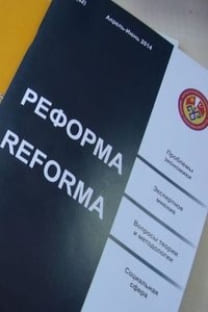NON-BANKING FINANCIAL SECTOR IN KYRGYZSTAN
non-banking finansial system, formal and informal finance
NON-BANKING FINANCIAL SECTOR IN KYRGYZSTAN
___
- Ayyagari, M., Demirgüç-Kunt, A., & Maksimovic, V. (2010). Formal versus informal finance: Evidence from China. Review of Financial Studies, 23(8), 3048-3097.
- Ghate, P.B. (1992). Interaction Between the Formal and Informal Financial Sectors: The Asian Experience. World Development, 20(6), 859-872.
- КРУБ, (2014). Отчет о стабильности финансового сектора Кыргызской Республики, Бишкек, июнь 2014, http://www.nbkr.kg/DOC/25072014/000000000027995.pdf
- КРУБ. Бюллетени, 2015.
- Капалова, A. (2014). Развитие малого и среднего бизнеса в Кыргызстане: неформальные коммуникации и роль женщин. Высшая Школа Развития, Институт государственного управления и политики, Доклад №25: http://www.ucentralasia.org/downloads/UCA-IPPA-Wp25-SmalMediumBusiness-Rus.pdf
- Курманбеков, Р.О. Теоретические основы использования инвестиционного потенциала небанковского финансового сектора: на примере страховых компаний и негосударственного пенсионного фонда в Кыргызской Республике: автореф. дисс. …канд. эконом. наук. 08.00.01. – Бишкек, 2014.
- Левченко, А.А. Влияние уровня жизни трудоспособного населения на миграционные процессы в Кыргызской Республике. – Бишкек, 2013: http://arch.kyrlibnet.kg/uploads/KNULEVCHENKOA.A.2013-7.pdf
- Международный валютный фонд. Кыргызская Республика. Среднесрочная программа развития/Документ по стратегии сокращения бедности. Май 2012 года: Доклад МВФ по стране, № 12/112.
- Мун, В.Г. (2008). Уровень благосостояния населения Кыргызстана на современном этапе: http://www.lib.krsu.edu.kg/uploads/files/public/2072.pdf
- Muratova, G. (2008). Развитие системы кредитных союзов в Кыргызстане: http://www.agrar.hu-berlin.de/de/institut/departments/dntw/tierhaltung/gefproj/gs_kirg/akt/archiv/SoSchu08/vortraege/vortr_kompr/pdf/12_GMuratova.pdf
- Schreiner, M. (2001). Informal finance and the design of microfinance. Development in Practice, 637-640.
- Shamshieva (2006). Microfinance Industry in Kyrgyzstan. Supervision and Regulation Issues. Microcredit Agency Bai Tushum Financial Foundation.
- Темиркулов, А.А. и др. (2013). Влияние родоплеменных (клановых) отношений на формирование (деформацию) механизмов государственного управления, негативные и положительные факторы: http://www.nisi.kg/uploads/research_ph/07_clans_report.pdf
- ISSN: 1694-5158
- Yayın Aralığı: Yılda 2 Sayı
- Başlangıç: 1999
- Yayıncı: Kırgızistan Türkiye Manas Üniversitesi
STATUS AND DEVELOPMENT OF THE FOOD AND PROCESSING INDUSTRY IN THE KYRGYZ REPUBLIC
GÜMRÜK BİRLİĞİ’NİN KAZAKİSTAN’IN İHRACATI ÜZERİNE ETKİSİNİN EKONOMETRİK ANALİZİ
STRUCTURAL CHANGES IN KYRGYZSTAN ECONOMY (2005-2010): AN INPUT-OUTPUT ANALYSIS
RURAL DEVELOPMENT AND INTEGRATED RURAL DEVELOPMENT STRATEGY
BY THE DEFINITION OF THE SUBJECT OF RESEARCH, LAWS AND REGULARITIES OF ECONOMIC DEVELOPMENT
ANALYSIS OF FACTORS AFFECTING CHOICE OF BANK
Ebru ÇAĞLAYAN-AKAY, Kamalbek KARYMSHAKOV, Raziya ABDİEVA, Gulmira TUTKABAEVA
ECONOMIC CONTENT OF EQUITY ORGANIZATIONS
Obolbek KURMANBEKOV, G. A. RYSKULOVA
DEBT FINANCING OF ECONOMY: FACTOR OF CRISIS OR FACTOR OF GROWTH?
İ. V. MANAHOVA, M. K. KUDAYKULOV
NON-BANKING FINANCIAL SECTOR IN KYRGYZSTAN
Harun DOGAN, Jusup PİRİMBAEV, Raziya ABDİEVA, Junus Ganiev, Aynura TURDALİEVA, Burulcha SULAİMANOVA, Dastan ASEİNOV
